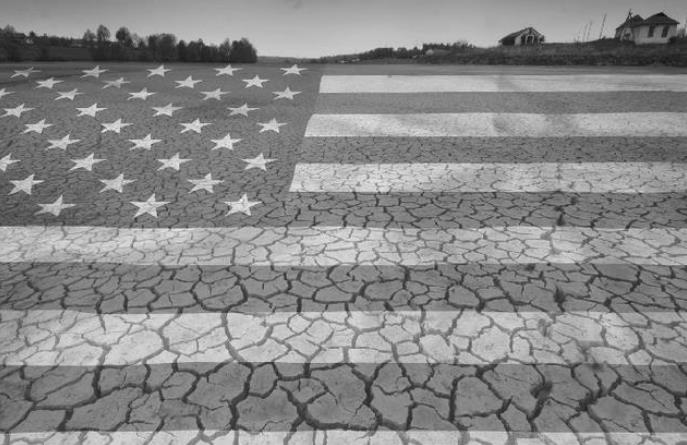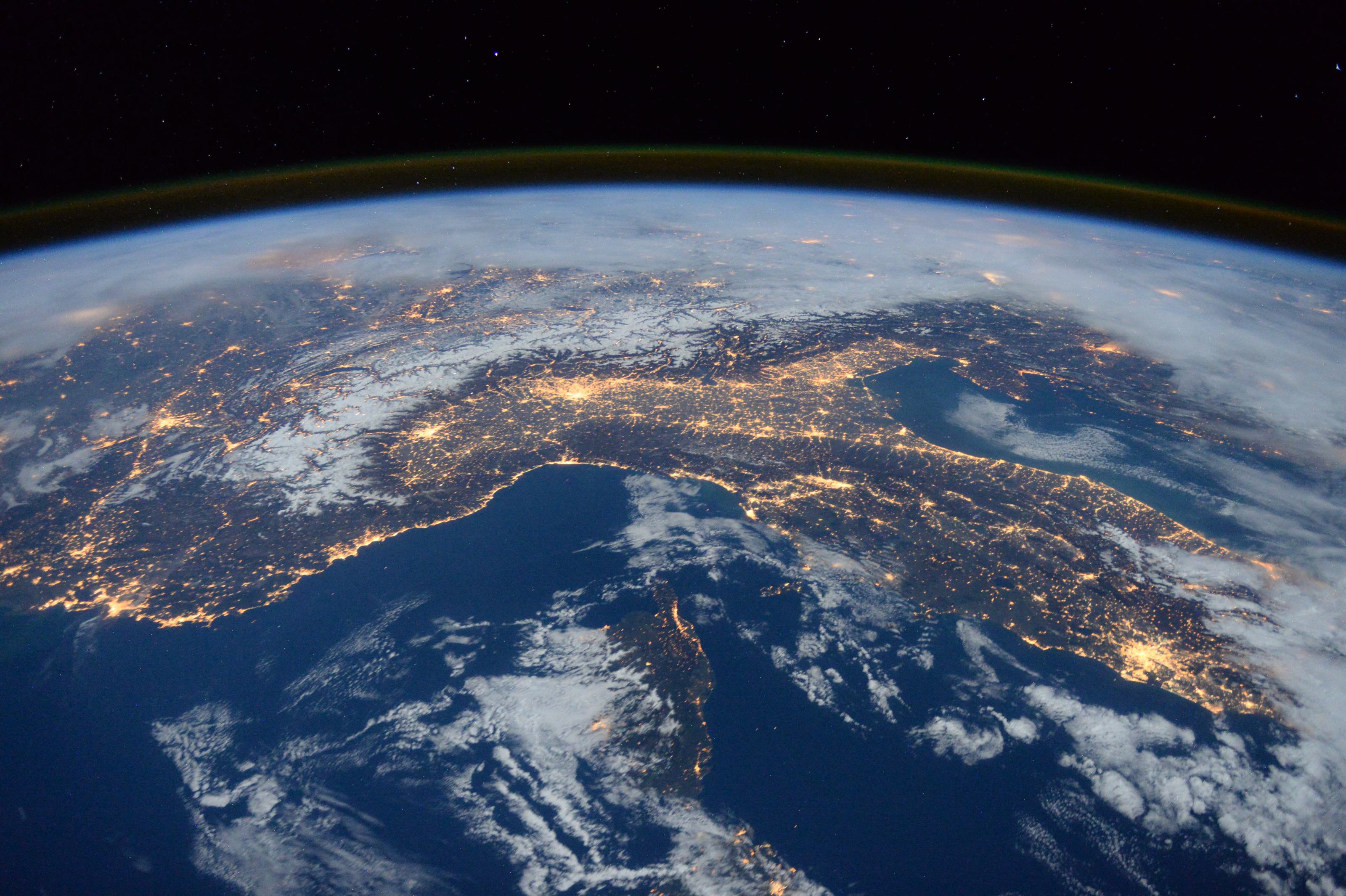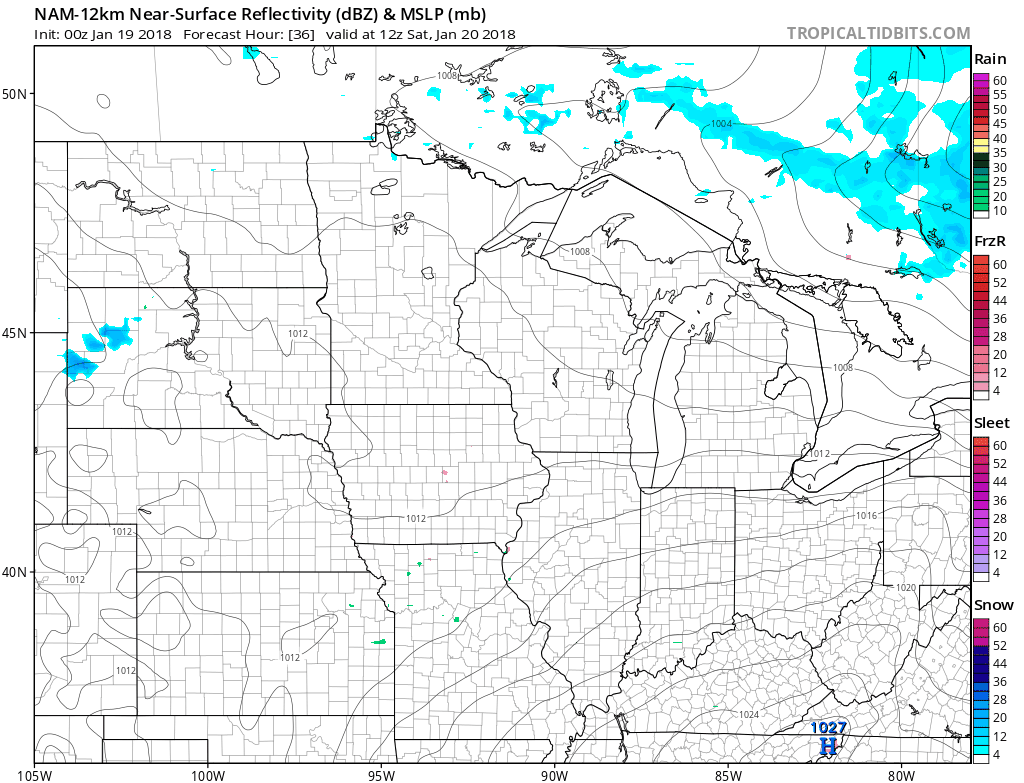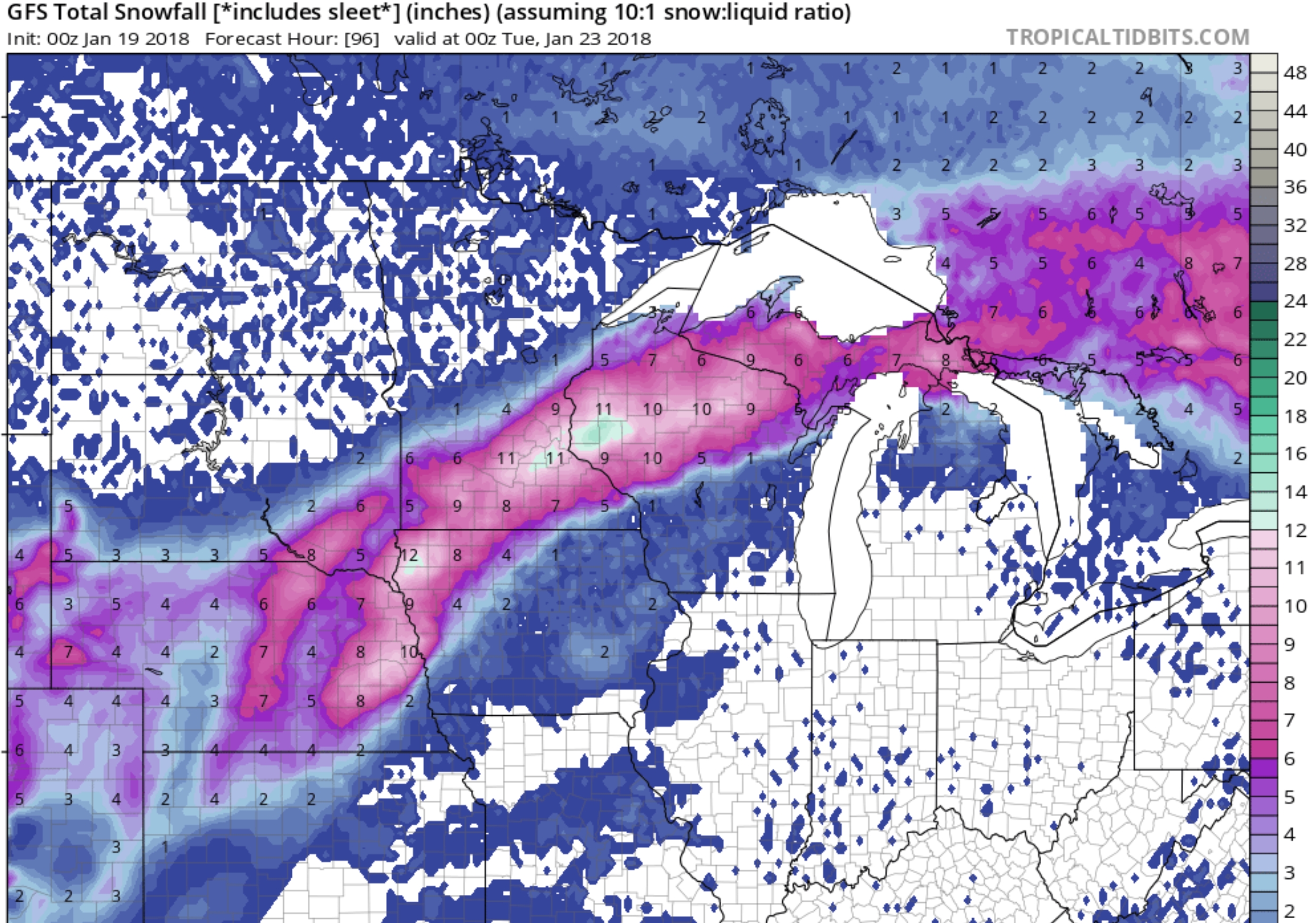Potential For a Real Storm Early Next Week?
Based on current trends, breaking news reports, CNN.com headlines and AP updates please predict what tomorrow’s biggest news stories will be – and why? Good luck. The official spread for Sunday’s NFC Championship is Vikings by 3 points, but which team will make fewer mistakes, turnovers and penalties – and why?
Impossible to predict with any level of specificity? So is Monday’s snowfall. The truth: we want to know – we DESERVE to know, but that doesn’t mean we have the data or science to be able to deliver. There are scores of weather models, simulations of what MAY unfold. The key is knowing what to believe, and when.
A storm tracking to our south will spread a mix into town late Sunday; it looks like all-snow by Monday as temperatures fall into the 20s. It’s too soon to say where the axis of heaviest snow will set up, but some lucky towns in central Minnesota may pick up 5-10 inches of slush. Once again the MSP metro may wind up on the edge of any plowable snow.
In the meantime enjoy 40s today & Saturday. Long-range models hint at 30s and slush for Super Bowl Sunday.
Models: Favorable Storm Track for Snow. Potentially significant snow for portions of Minnesota late Sunday into Monday, but it’s still too early to know where the heaviest snow bands will set up. That said, this may be the best chance at a plowable snowfall for a fairly big chunk of the state all winter, to date. We’re due. NAM guidance: NOAA and tropicaltidbits.com.
Model Spread. Anywhere from 3-8″, give or take. Better yet, a coating to 2 feet. Your results may vary. It’s still too early to toss around inch-amount forecasts, but plowable seems likely for much of the state. No, it won’t be a crippling storm but Monday may be a slow travel day.
Snowfall By Monday Morning. 12km NAM guidance only goes out 84 hours, so last night’s 00z run ended Monday morning. By then much of central and southwestern Minnesota is forecast to have 4-7″ of snow.
GFS Solution. No, this does NOT mean that the metro area is a shoe-in for 8-11″ of snow, but I wanted to show you where the axis of heaviest snow is forecast to set up. Watch how this shifts and migrates over time, as the forecast track fluctuates from model run to run. Nothing is etched in stone yet (it never is).
Thaw Into Sunday, Then Cooling Off. No more arctic air is brewing anytime soon, nothing below 0F through the end of January. I still maintain the worst of the chill is behind us, in terms of length and severity of hours below 0F. Place your bets. Temperatures return to average the last week of January, but nothing that will make you wince. Twin Cities ECMWF numbers: WeatherBell.
Billion Dollar Weather and Climate Disasters in 2017. Here’s a summary from NOAA: “In 2017, there were 16 weather and climate disaster events with losses exceeding $1 billion each across the United States. These events included 1 drought event, 2 flooding events, 1 freeze event, 8 severe storm events, 3 tropical cyclone events, and 1 wildfire event. Overall, these events resulted in the deaths of 362 people and had significant economic effects on the areas impacted. The 1980–2017 annual average is 5.8 events (CPI-adjusted); the annual average for the most recent 5 years (2013–2017) is 11.6 events (CPI-adjusted).During 2017, the U.S. experienced a historic year of weather and climate disasters. In total, the U.S. was impacted by 16 separate billion-dollar disaster events tying 2011 for the record number of billion-dollar disasters for an entire calendar year. In fact, 2017 arguably has more events than 2011 given that our analysis traditionally counts all U.S. billion-dollar wildfires, as regional-scale, seasonal events, not as multiple isolated events.
More notable than the high frequency of these events is the cumulative cost, which exceeds $300 billion in 2017 — a new U.S. annual record. The cumulative damage of these 16 U.S. events during 2017 is $306.2 billion, which shatters the previous U.S. annual record cost of $214.8 billion (CPI-adjusted), established in 2005 due to the impacts of Hurricanes Dennis, Katrina, Rita and Wilma.
The U.S. has sustained 219 weather and climate disasters since 1980 where overall damages/costs reached or exceeded $1 billion (including CPI adjustment to 2017). The total cost of these 219 events exceeds $1.5 trillion. This total now includes the initial cost estimates for Hurricanes Harvey, Irma and Maria…”
Themometer in World’s Coldest Village Breaks as Temperatures Plunge to -62C. That’s -79.6F air temperature. The Independent has the chilling details: “The thermometer in a remote Siberian village known as the coldest inhabited place on earth has broken as temperatures plunged to near-record depths. The public device, which was installed in Oymyakon as a tourist attraction, recorded -62C, before malfunctioning this week. Meanwhile the Siberian Times reports that some locals had readings as low as -67C – in touching distance of the record -67.7C, which was logged in the village in February 1933…”
Photo credit: “The thermometer in Oymyakon stopped working shortly after temperatures reached -62C.” Credit: Instagram/@sivtseva9452.
The Siberian Times has more amazing photos from the cold wave here.
Seismic Sensors Record Hurricane Activity. A story at Phys.org made me do a double-take: “..Scientists have known since the beginning of the 20th century that large storms in the ocean, including tropical cyclonnes (also known as “hurricanes” and “typhoons”), leave their signature in seismic data. The signal comes from the ocean waves generated by the hurricane’s strong winds. But they’re not just any waves. “The waves you see when you go to the beach are not enough,” says Gualtieri, who led the study as a postdoctoral researcher at Columbia University’s Lamont Doherty Earth Observatory...”
File image of Hurricane Gaston: NOAA and AerisWeather.
No Tornado-Related Deaths in the USA for a Record 240 Days. So says The Weather Channel; here’s an excerpt: “…The last tornado fatalities were reported on May 16, 2017, in Wisconsin and Texas. Since then, 245 days (as of Jan. 16) have gone by without a twister taking a life, easily besting the previous record-long streak of 219 days set June 25, 2012-Jan. 29, 2013. Before that, the record was a 197-day span that ended Feb. 28, 1987. This streak is in big contrast to how the first half of 2017 unfolded when a rash of tornado outbreaks occurred early in the year. By mid May of last year, 34 people had lost their lives from tornadoes…”
Their Continuing Mission: Hurricane Hunters Gather Data for Winter Storms. Here’s an excerpt of a post from The U.S. Air Force: “Some people might think that when hurricane season comes to an end, so does the mission of the Air Force Reserve “Hurricane Hunters.” But that’s not the case. For members of the 53rd Weather Reconnaissance Squadron, also known as the Hurricane Hunters, the hurricane tasking is only one part of their overall data-gathering mission. Hurricane Hunters track winter storms off the East and West Coast of the United States and in the Gulf of Mexico. While the normal flying season for these missions runs Nov. 1 to March 31, some missions can take place either before or after these dates depending on the weather that season. “So far this season, the Hurricane Hunters have flown two winter storm missions, one today and the other Jan. 3. The data from these and other winter storm missions help forecasters determine what type of weather conditions these storms might bring to coastal communities and even further inland, whether it be freezing rain, sleet, ice or snow.” said Maj. Christopher Dyke, 403rd Operations Group weather standards and evaluation officer...”
Photo credit: “Aircrew members from the 53rd Weather Reconnaissance Squadron “Hurricane Hunters” taxi a WC-130J Super Hercules aircraft to its parking spot on the runway at Keesler Air Force Base, Miss., after a winter storm flight Jan. 12, 2018. In addition to their hurricane taskings, Hurricane Hunters fly winter storm missions to gather weather data used by forecasters in generating models for systems that could affect the East, West or Gulf Coast of the United States.” (U.S. Air Force photo by Tech. Sgt. Ryan Labadens).
In a new study, Gualtieri and her colleagues have found that those seemingly trivial blips can actually encode the power of hurricanes moving over ocean waters. The findings may make it possible to estimate the strength of past hurricanes, to reveal how climate change is influencing the severity and frequency of these storms.
Seismic Fingerprints
Scientists have known since the beginning of the 20th century that large storms in the ocean, including tropical cyclones (also known as “hurricanes” and “typhoons”), leave their signatures in seismic data. The signal comes from the ocean waves generated by the hurricane‘s strong winds. But they’re not just any waves. “The waves you see when you go to the beach are not enough,” says Gualtieri, who led the study as a postdoctoral researcher at Columbia University’s Lamont Doherty Earth Observatory.
NOAA’s Future Constellation: Large and Small Satellites In Variety of Orbits. SpaceNews.com explains the evolution of weather satellites over time: “In the future, the U.S. National Oceanic and Atmospheric Administration may rely on a mix of large government owned and operated satellites, imaging instruments hosted on commercial satellites, small satellites in low Earth orbit and data purchased from commercial firms. That was one of the key findings of an extensive quantitative analysis NOAA’s Satellite and Information Service performed over the last two years to identify ways to create an increasingly capable and resilient space-based architecture in light of budget constraints. The NOAA Satellite Observing System Architecture (NSOSA) study evaluated about 100 possible constellations, ranging from continuing its existing model of relying almost exclusively on a handful of large government owned and operated satellites to radical alternatives with swarms of small satellites...”
Graphic credit: “This was NOAA’s constellation before GOES-16 moved into position as GOES-East and retired GOES-13. NOAA’s future constellation may include hosted payloads and small satellites in low Earth orbit.” Credit: NOAA.
Ford “All In” On EVs: From Climate Nexus Hot News: “Ford Motors will spend billions on electric vehicle development and create dozens of electric models by 2022, the company announced Sunday. Speaking at the Detroit Auto Show, Chairman Bill Ford said the auto giant would spend $11 billion to provide 40 models of electric and hybrid vehicles for its 2022 rollout, including 16 fully electric models and a possible all-electric SUV. “We’re all in on this,” Ford told reporters. “We’re taking our mainstream vehicles, our most iconic vehicles, and we’re electrifying them.” The move comes as other auto giants, including Toyota and Volkswagen, commit to spending billions on EV development and models through the early 2020s.” (Reuters, TechCrunch, The Guardian, Bloomberg, MarketWatch, BBC)
Electricity From All Forms of Renewables Will Be Consistently Cheaper Than Fossil Fuels by 2020. Quartz explains: “Turning to renewables for new power generation is not simply an environmentally conscious decision, it is now overwhelmingly a smart economic one,” said Adnan Amin, who has the numbers to back it up. Amin heads the International Renewable Energy Agency (Irena), and the numbers can be found in a new report the agency released at its annual summit on Jan. 13 in Abu Dhabi. In most of the world, renewable electricity is already competitive with fossil-fuel power. Better still, the report makes the extraordinary prediction: By 2020, all forms of renewable electricity will be consistently cheaper than power produced by burning fossil fuels…”
Photo credit: “A new dawn.” (Reuters/Marcelo del Pozo
RENEWABLES: From Climate Nexus Hot News: “US working hard to boost wind energy, adviser says in Denmark (Bloomberg), France plans to accelerate wind power projects (Reuters), Saudi Arabia plans up to $7 billion of renewable energy projects this year (Bloomberg), for a vision of offshore wind in New England, look to the UK” (WBUR)
Image credit: Greentech Media.
Lilium Receives $90 Million to Build Electric Flying Taxi. Is this how our kids will be commuting? Here’s an excerpt from The Verge: “German start-up Lilium has secured $90 million in funding to build a five-seat, all-electric flying taxi. The funding will be used to develop the company’s five-seat commercial Lilium Jet, as well as to grow the company’s team of more than 70 people. As envisioned, a fully charged Lilium Jet would be able to stay aloft for about an hour and travel at speeds in excess of 180 mph. It will also have an on-demand feature where users can order the air taxi to a nearby landing pad...”
One Benefit To Living in Michigan? I found a post at mlive.com somewhat amusing, extolling the virtues of living in natural disaster-proof Michigan! Of course Michigan does see tornadoes and blizzards and lake effect snow and numbing cold, but in a relative sense, the threat is, in fact, lower than much of the USA: “This map, which sources the American Red Cross and National Oceanic and Atmospheric Administration, shows where natural disasters like earthquakes, tornadoes, flooding and hurricanes are most frequent. Unsurprisingly, earthquakes are most likely on the west coast. Meanwhile, the plains states make up “Tornado Alley” and the southeast is susceptible to hurricanes. In fact, virtually every state is at risk for a natural disaster of some kind. Except one. Michigan. As you can see on the map, Michigan’s peninsulas are colored white, which means there’s little risk of earthquakes, tornadoes or hurricanes...”
4″ snow on the ground at MSP International Airport Thursday morning.
41 F. high yesterday in the Twin Cities.
23 F. average high on January 18.
41 F. high on January 18, 2017.
January 19, 1994: The cold continues from the previous day with a low of -47 at Brainerd and, despite the heat island effect, the Twin Cities’ airport hit -27.
FRIDAY: Patchy clouds, balmy. Winds: SW 8-13. High: 42
FRIDAY NIGHT: Clouds and fog. Low: 28
SATURDAY: Clouds linger, no travel problems. Winds: NW 5-10. High: 41
SUNDAY: Gray, light mix or wet snow arrives late. Winds: NE 7-12. Wake-up: 29. High: 37
MONDAY: Wet snow, enough to plow/shovel? Winds: NE 10-20. Wake-up: 30. High: 32
TUESDAY: Peeks of sun, a chilled breeze. Winds: NW 8-13. Wake-up: 11. High: 19
WEDNESDAY: Partly sunny, closer to average temps. Winds: SE 5-10. Wake-up: 6. High: 25
THURSDAY: Mostly cloudy and milder again. Winds: SE 8-13. Wake-up: 21. High: 36
Climate Stories…
2017 Was Among the Planet’s Hottest Years on Record, NASA and NOAA Scientists Report. Chris Mooney reports for The Washington Post: “2017 was among the hottest years ever recorded, government scientists reported Thursday. The year was the second-hottest in recorded history, NASA said, while scientists from the National Oceanic and Atmospheric Administration reported 2017 was the third-warmest they’ve ever recorded. “The planet is warming remarkably uniformly,” said Gavin Schmidt, director of NASA’s Goddard Institute for Space Studies, on a press call to share the results with reporters. The two government agencies use different methodologies to calculate global temperatures, but by either standard, the 2017 results make the past four years the hottest period in their 138-year archive…”
NOAA: 2017 wasa 3rd Warmest Year on Record for the Globe. NOAA has the details: “Earth’s globally averaged temperature for 2017 made it the third warmest year in NOAA’s 138-year climate record, behind 2016 (warmest) and 2015 (second warmest). However, unlike the past two years, Earth’s average temperature in 2017 was not influenced by the warming effect of an El Nino, say scientists from NOAA’s National Centers for Environmental Information (NCEI). The average temperature across the globe in 2017 was 1.51 degrees F above the 20th century average of 57 degrees F. 2017 marks the 41st consecutive year (since 1977) with global land and ocean temperatures at least nominally above the 20th-century average. The six warmest years on record for the planet have all occurred since 2010...”
-
The month of December: Despite the cooling influence of a weak La Nina in the latter part of the year, December ended up as the fourth warmest December on record for the globe, with an average temperature 1.44 degrees F above the 20th century average.
-
The globally averaged sea surface temperature was the third highest on record, 1.21 degrees F above average.
-
The globally averaged land surface temperature was the third highest on record, 2.36 degrees F above average.
-
Continental warmth: South America had its second warmest year on record; Asia, its third; Africa, its fourth; Europe, its fifth; and North America and Oceania, their sixth.
-
The average Arctic sea ice extent for the year was 4.01 million square miles, the second smallest annual average since record-keeping began in 1979.
-
The average Antarctic sea ice extent for the year was 4.11 million square miles, the smallest annual average since record-keeping began in 1979.
Animals Are Shrinking and Freezing to Death in a Changing Arctic. Here’s the intro to a National Geographic story: “Muskoxen, the plant-chomping, long-haired mammals that huddle on the Arctic tundra, are being born smaller in parts of the far north, as pregnant mothers struggle to find food. One reason, according to new research published Thursday in Scientific Reports: Muskoxen eat most of the year by pawing through snow with their hooves. But rising temperatures mean precipitation increasingly falls as rain, only to then freeze on the surface, encasing plant life in inaccessible ice. Meanwhile, in a type of freak weather event likely to become more common, more than 50 muskoxen died swamped in ice, as gusts of howling winds drove ice and freezing waters from a tidal surge so far inland that fish were found a half-mile from shore...”
Photo credit: “Muskoxen don’t migrate long distances, the way caribou do, so they are susceptible to dramatic weather changes.” Credit: Joel Berger, WCS.
Humans Did Not Cause the U.S. Cold Snap. Natural variability? Probably, according to a summary of new research at Scientific American: “…In recent years, climate scientists have studied the connection between global warming and freezing temperatures. They are examining how shifting air patterns over the Arctic, and their incursion into North America and Europe, are connected to climate change. But the two-week deep freeze didn’t carry the hallmarks of human activity, according to a rapid attribution study from Climate Central, a science communication project based in Princeton, N.J. World Weather Attribution, a group of international researchers, performed the analysis…”We conclude that this was an exceptional two-week cold wave in the area in the current climate,” the authors wrote. “Cold outbreaks like this are getting warmer (less frequent) due to global warming, but cold waves still occur somewhere in North America almost every winter...”

Congress Ignores Biggest Security Risk: Climate Change. Here’s an excerpt of an Op-Ed at The San Francisco Chronicle: “…The act also warns that rising sea levels “will threaten the operations of more than 128 United States military sites,” that permafrost melting is jeopardizing “radar and communication installations, runways, seawalls, and training areas” in the Arctic, and that drought-fed wildfires have damaged “roads, runways, and buildings on military bases” in the Western United States. Yet in the recent tax bill, Congress for the first time approved oil drilling in the pristine Arctic National Wildlife Refuge. Promoting greater use of fossil fuels can only accelerate the threat of global warming, which contributed to storms and fires that cost the United States a record $300 billion in 2017, according to a recent analysis issued by the National Oceanic and Atmospheric Administration…”

Are Our Better Lives Today Robbing Future Generations of a Livable World? A story at Quartz examines the ethical question: “…We may be living longer, but we are doing it in a way that will rob our children of their health, well-being and long lives,” said Gina McCarthy, who served as administrator of the Environmental Protection Agency during the Obama Administration. “We need to be looking at how human interference in Earth’s natural systems is playing out, and how humans are changing them. We also must find different solutions, not the traditional ones.” This means society must begin to focus more on the health of forthcoming generations, a process that will require “a game-changing shift in thinking,” said Susanne Sokolow, a senior research scientist at the Stanford Woods Institute for the Environment...”
Image credit: Reuters/Tim Peake and NASA.




